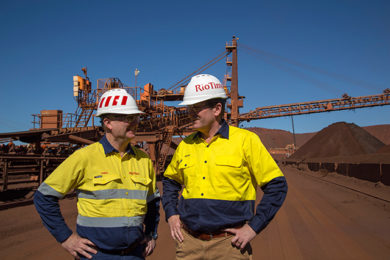Rio Tinto Iron Ore has commenced a major sustaining capital project, spending almost $39 million (A$50 million) to replace the original stackers at the Paraburdoo mine which will create almost 100 jobs. Global advanced technology provider Tenova TAKRAF is leading the design and implementation phases of the stacker replacement and has committed to sourcing all material and equipment from well known, reputable suppliers with a preference for local content.
Tenova’s engineering technology centre in Perth will manage all the lead engineering work to replace the stackers, which are large pieces of machinery used to evenly distribute ore into stockpiles. West Australian Premier Mark McGowan visited Paraburdoo to mark the start of the project. The design of the new stackers is underway and fabrication is expected to begin later this year with installation and commissioning completed by 2020.
The design phase will create approximately 10 to 15 Perth-based roles. So far, the project has awarded a multi-million dollar subcontract to Western Australian company Paradigm Engineers to provide electrical engineering design and control system programming services, as well as the supply of electrical equipment.
Around 80 Western Australian based roles are likely to be required during implementation. Fabrication, including pre-assembly, will take place in a local Perth workshop. Up to 30 Pilbara-based roles will be required to prepare the site and install the plant. Rio Tinto Iron Ore chief executive Chris Salisbury said: “This is great news not only for Paraburdoo, but also for jobs here in WA. This project is an important part of our sustaining capital programme for 2018 and we’re pleased to be supporting local businesses with this significant body of work. A further feature of our commitment to local jobs is our local procurement programme that we launched last year. The programme already has over 750 business registrations and more than 200 packages of work placed online.”
The old stackers were part of the mine’s original infrastructure, stacking the very first load of iron ore from Paraburdoo in 1972. In 46 years of operation, they’ve stacked just over 800 Mt of iron ore, requiring only minimal structural changes throughout that time.
The project forms part of Rio Tinto’s broader sustaining capital programme estimated at $1 billion a year over the next three years. The company is also investing in replacing depleting assets with an estimated $2.2 billion expected to be spent on replacement mines over the next three years.
Features of the new stackers include:
- Modern advances in engineering design and mechanical technology
- Latest generation variable-speed drive control and fibre optic network infrastructure
- Anti-collision system with GPS back up
- Fully automated and monitored from the Operations Centre in Perth










